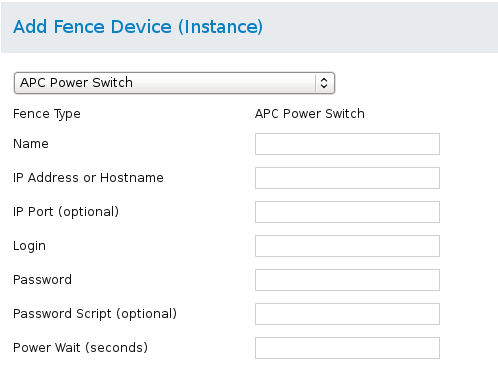Chapter 4. Fence Devices
This chapter documents the fence devices currently supported in Red Hat Enterprise Linux High-Availability Add-On.
Table 4.1, “Fence Device Summary” lists the fence devices, the fence device agents associated with the fence devices, and provides a reference to the table documenting the parameters for the fence devices.
4.1. APC Power Switch over Telnet and SSH
Copy linkLink copied to clipboard!
Table 4.2, “APC Power Switch (telnet/SSH)” lists the fence device parameters used by
fence_apc, the fence agent for APC over telnet/SSH.
| luci Field | cluster.conf Attribute | Description |
|---|---|---|
| Name | name | A name for the APC device connected to the cluster into which the fence daemon logs by means of telnet/ssh. |
| IP Address or Hostname | ipaddr | The IP address or host name assigned to the device. |
| IP Port (optional) | ipport | The TCP port to use to connect to the device. The default port is 23, or 22 if Use SSH is selected. |
| Login | login | The login name used to access the device. |
| Password | passwd | The password used to authenticate the connection to the device. |
| Password Script (optional) | passwd_script | The script that supplies a password for access to the fence device. Using this supersedes the parameter. |
| Power Wait (seconds) | power_wait | Number of seconds to wait after issuing a power off or power on command. |
| Power Timeout (seconds) | power_timeout | Number of seconds to continue testing for a status change after issuing a power off or power on command. The default value is 20. |
| Shell Timeout (seconds) | shell_timeout | Number of seconds to wait for a command prompt after issuing a command. The default value is 3. |
| Login Timeout (seconds) | login_timeout | Number of seconds to wait for a command prompt after login. The default value is 5. |
| Times to Retry Power On Operation | retry_on | Number of attempts to retry a power on operation. The default value is 1. |
| Port | port | The port. |
| Switch (optional) | switch | The switch number for the APC switch that connects to the node when you have multiple daisy-chained switches. |
| Delay (optional) | delay | The number of seconds to wait before fencing is started. The default value is 0. |
| Use SSH | secure | Indicates that system will use SSH to access the device. When using SSH, you must specify either a password, a password script, or an identity file. |
| SSH Options | ssh_options | SSH options to use. The default value is -1 -c blowfish. |
| Path to SSH Identity File | identity_file | The identity file for SSH. |
Figure 4.1, “APC Power Switch” shows the configuration screen for adding an APC Power Switch fence device.
Figure 4.1. APC Power Switch
The following command creates a fence device instance for a APC device:
ccs -f cluster.conf --addfencedev apc agent=fence_apc ipaddr=192.168.0.1 login=root passwd=password123
ccs -f cluster.conf --addfencedev apc agent=fence_apc ipaddr=192.168.0.1 login=root passwd=password123
The following is the
cluster.conf entry for the fence_apc device:
<fencedevices> <fencedevice agent="fence_apc" name="apc" ipaddr="apc-telnet.example.com" login="root" passwd="password123"/> </fencedevices>
<fencedevices>
<fencedevice agent="fence_apc" name="apc" ipaddr="apc-telnet.example.com" login="root" passwd="password123"/>
</fencedevices>
